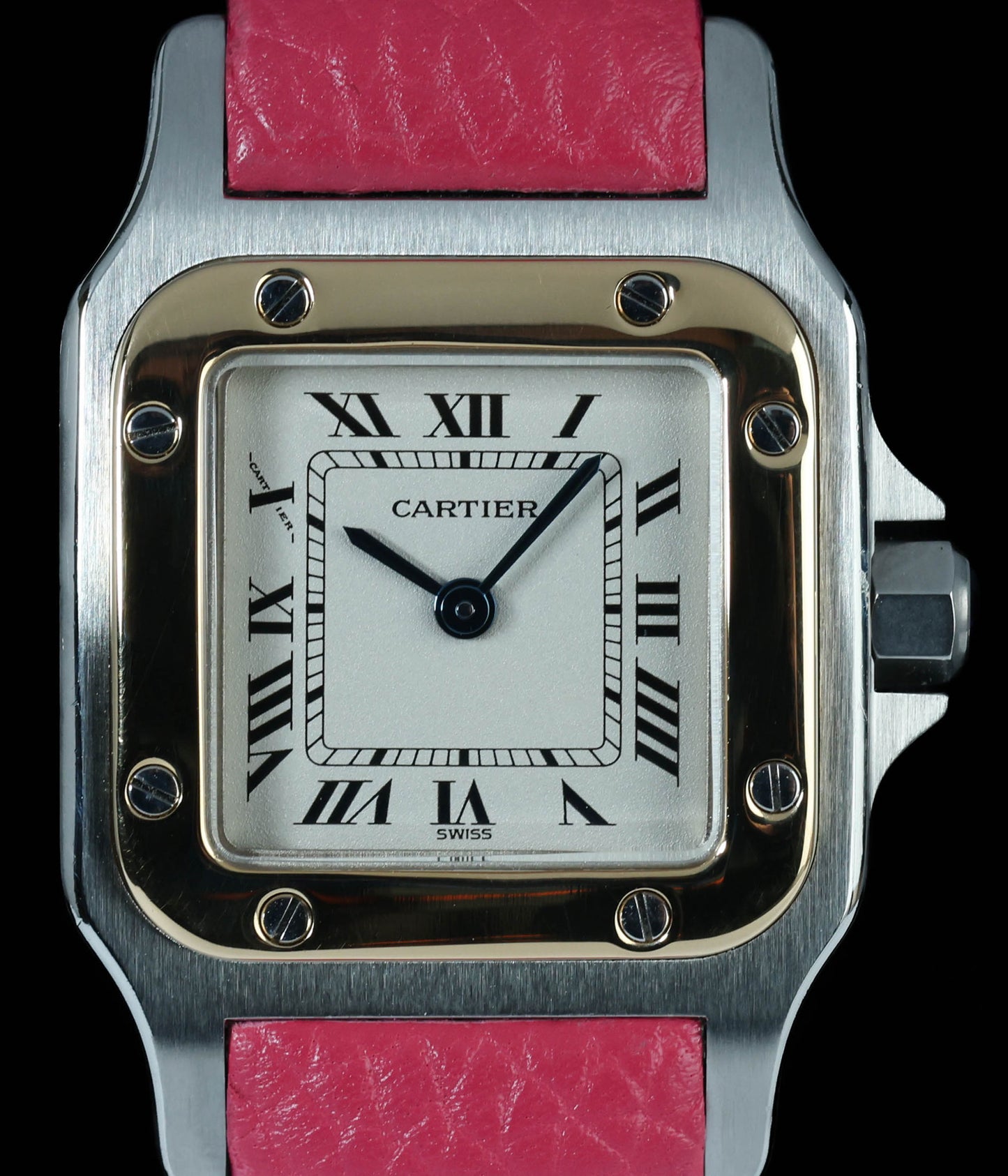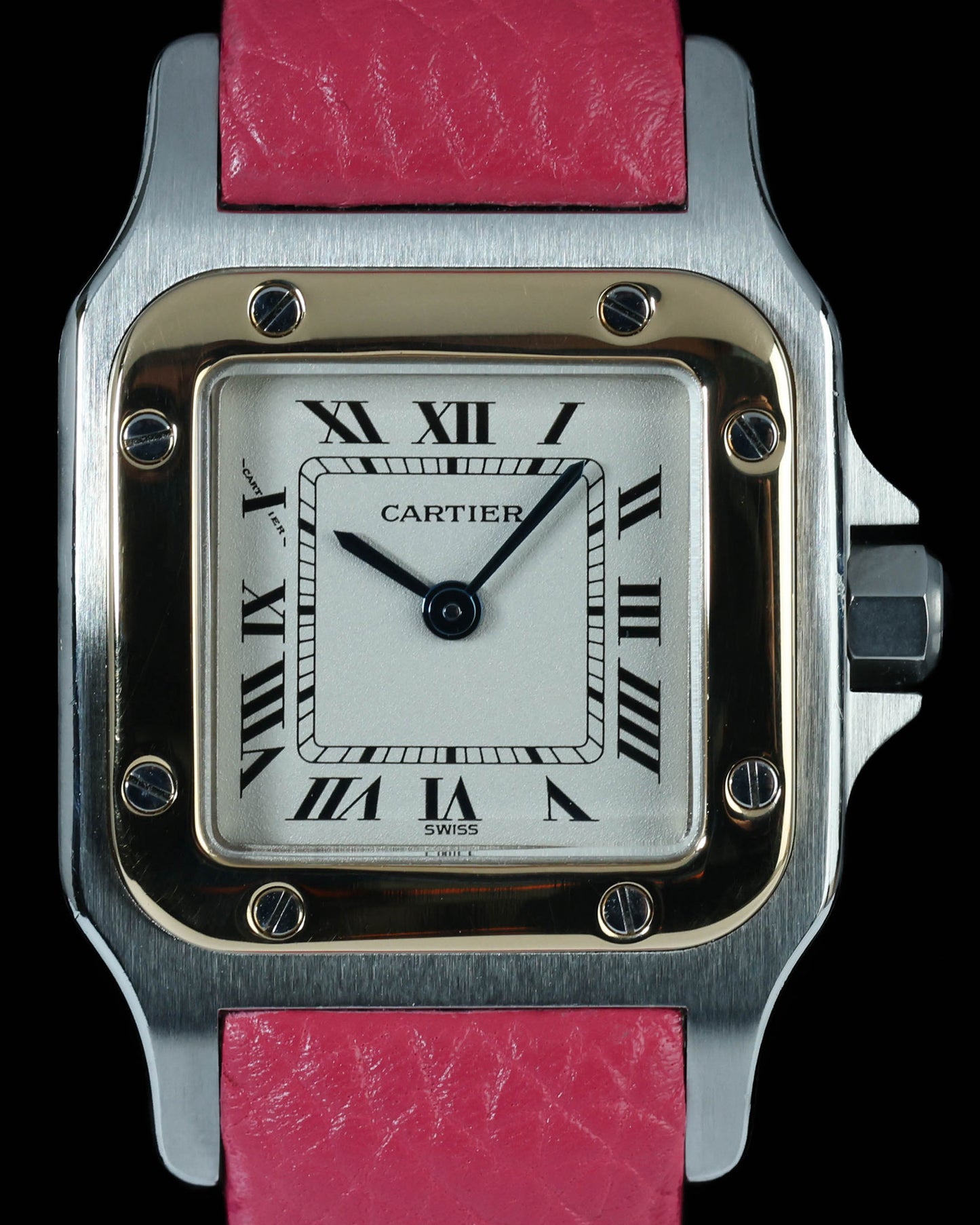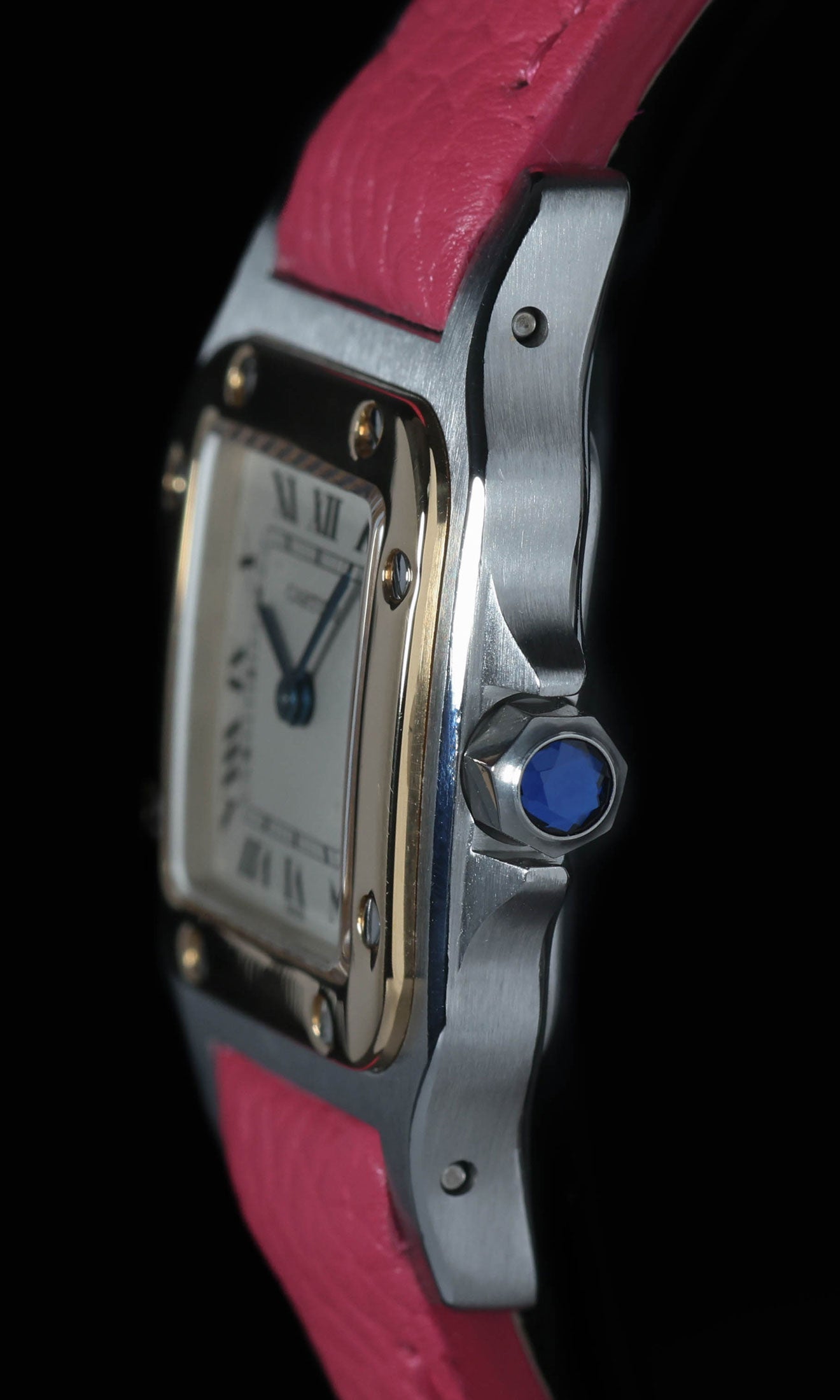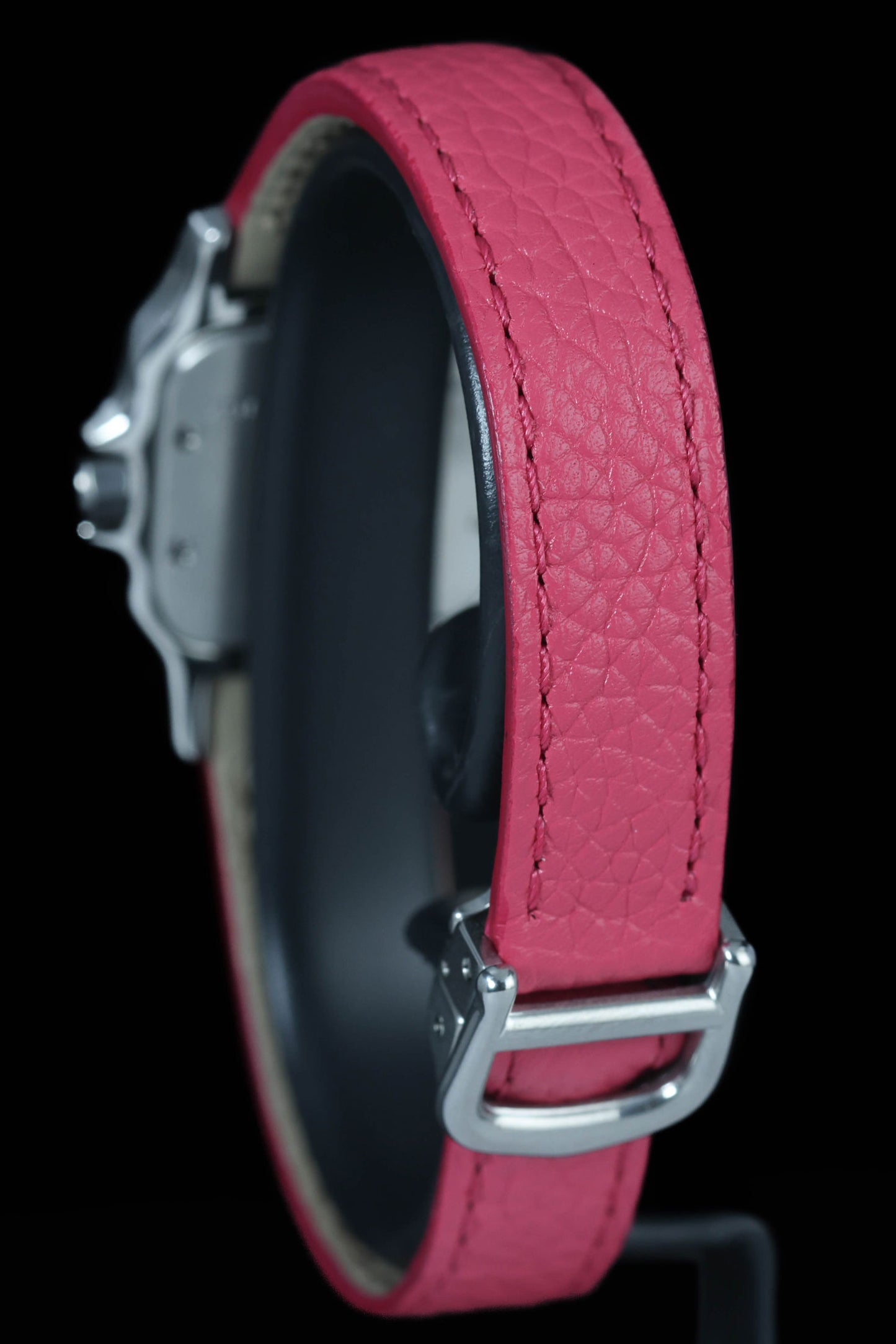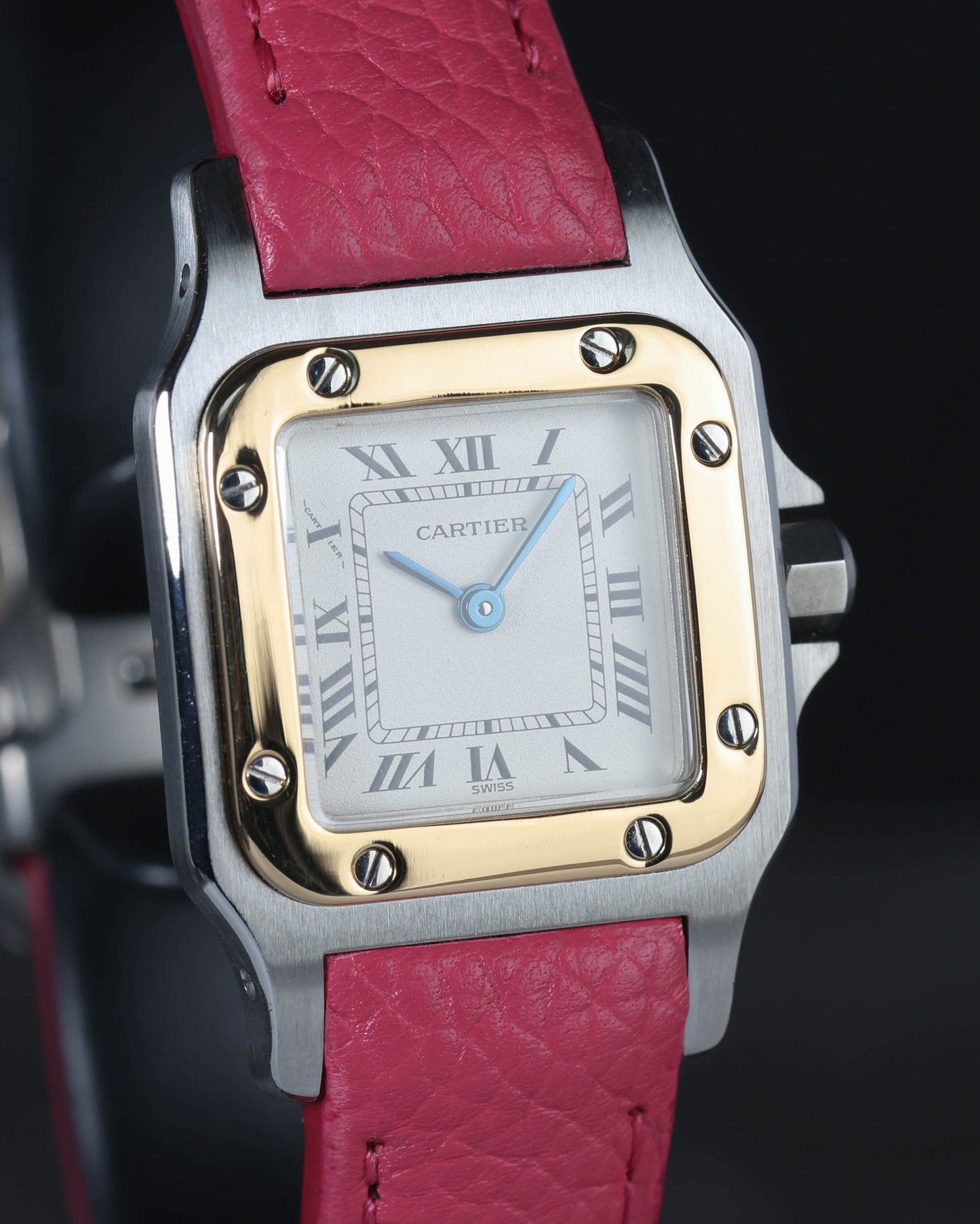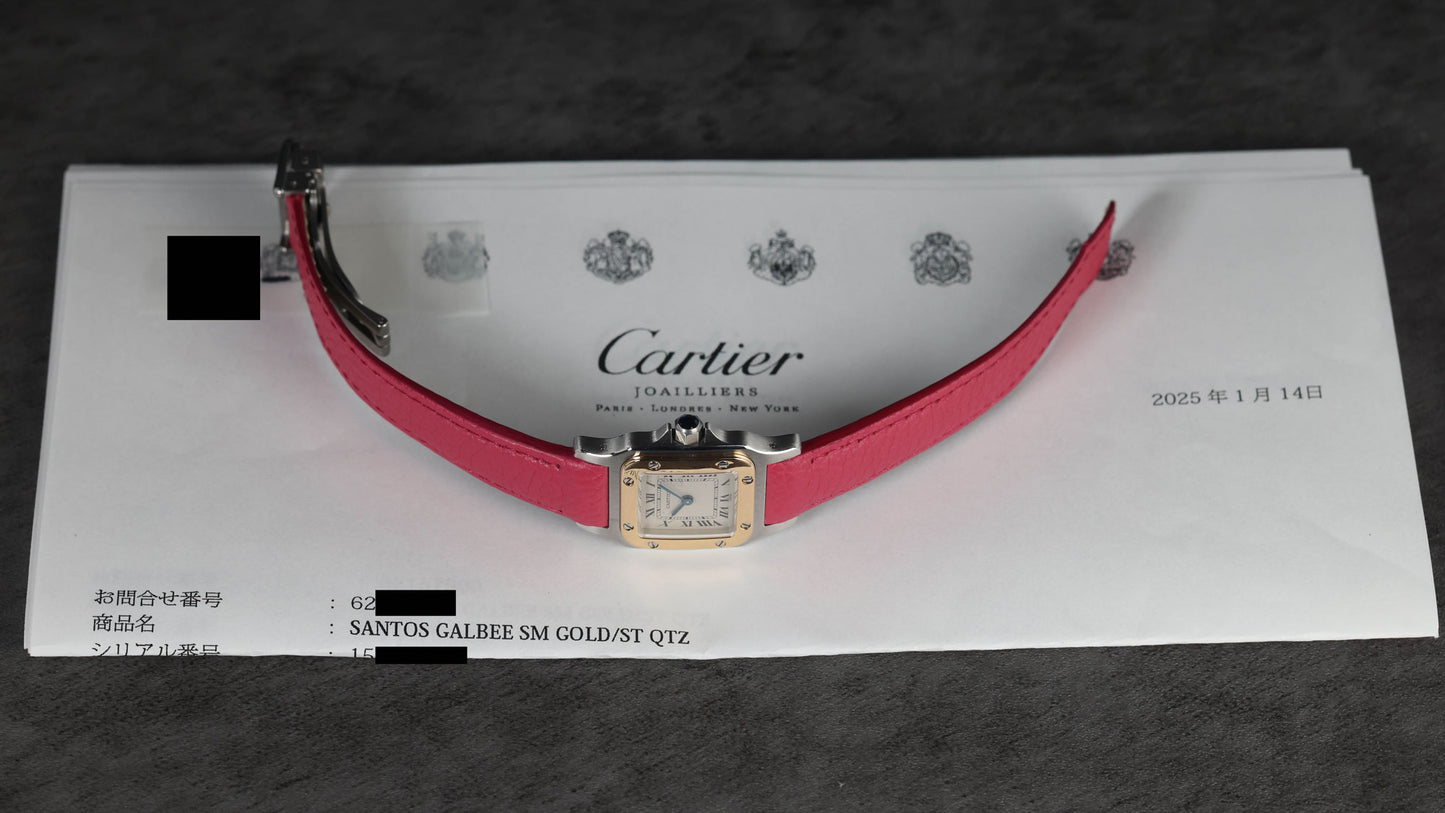Crown Vintage
Cartier Santos Galbee 1567 24MM
Cartier Santos Galbee 1567 24MM
Couldn't load pickup availability
Cartier Santos Gablee 1567
The stainless-steel case presents in very good condition with only faint, superficial marks consistent with careful use; edges remain crisp. A near-new Cartier pink leather strap with signed deployant clasp shows virtually no creasing. The watch was recently serviced by Cartier, so the movement is running accurately and all gaskets have been renewed. Dial and blued-steel sword hands are flawless, with clean printing, sharp Roman numerals and undiminished luminance. Overall, this Santos 1567 is a well-preserved example requiring no immediate attention.
Share
Why we love this watch
Why we love this watch
Cartier Santos 1567: Galbée Elegance and the Evolution of the First Pilot’s Wristwatch
Introduction
Reference 1567 belongs to the Santos Galbée family, the late-1980s refresh that smoothed the straight-edged Santos de Cartier case into a subtle curve. In two-tone steel and yellow gold it measures 24 mm across and 35 mm lug to lug, powered by a thin, high-accuracy quartz calibre, rated to 30 metres and capped by an integrated bracelet whose gold screws echo the bezel. What looks like a chic everyday watch is, in fact, the latest chapter in the story of the very first purpose-built wristwatch.
Cartier before the wristwatch
Louis-François Cartier assumed control of his master’s Paris workshop in 1847 and, by focusing on platinum jewellery and refined objets d’art, quickly found favour with the French court. His son Alfred deepened that aristocratic client base, but it was Alfred’s three sons—Louis in Paris, Pierre in New York and Jacques in London—who transformed Cartier into an international maison. By the turn of the twentieth century Cartier was supplying tiaras to European royalty, producing its enigmatic mystery clocks and experimenting with small, jewelled timekeepers worn on bracelets by fashionable women.
Alberto Santos-Dumont and the birth of the pilot’s watch
Among Louis Cartier’s circle of Parisian friends was the Brazilian aviation pioneer Alberto Santos-Dumont. In 1904 Santos-Dumont complained that retrieving a pocket watch mid-flight was cumbersome. Cartier solved the problem with a flat, square watch fixed to a leather strap: the first wristwatch expressly designed for men and the first dedicated pilot’s watch. Its shape was a deliberate nod to contemporary Parisian architecture, emulating the square plan of the Eiffel Tower’s top platform, while the bold Roman numerals maximised legibility. Commercial production began in 1911 using movements supplied by Edmond Jaeger, and the watch was simply titled “Santos-Dumont,” later shortened to “Santos.” Even at that early stage Cartier patented a folding clasp, evidence that ergonomics mattered as much as aesthetics.
Evolution between the wars and into the jet age
For decades the Santos remained a precious-metal dress piece, offered mostly in yellow gold on leather. During the Art Deco period Cartier refined the model with a beaded crown topped by a sapphire cabochon and a closed chemin-de-fer minute track—both details that survived every later redesign. Post-Second World War tastes shifted toward practical steel sport watches, but Cartier resisted, believing the Santos should remain a refined object. That changed in 1978 when the maison responded to the quartz crisis by launching the Santos de Cartier: the familiar square case rendered in stainless steel with a contrasting yellow-gold bezel and eight exposed screws. A matching steel-and-gold bracelet with visible screw heads tied the package together and echoed the industrial chic pioneered by Gérald Genta’s Royal Oak. Quartz movements offered bulletproof accuracy, while the daring two-tone palette made the new Santos visually distinctive yet more affordable than its solid-gold forebears.
Birth of the Galbée and the arrival of Reference 1567
By 1987 Cartier sensed the need for refinement. The Santos de Cartier’s flat flanks and abrupt corners felt severe next to the softer shapes favoured in late-’80s design, so the maison unveiled the Santos Galbée—“galbée” meaning curved or profiled. The bezel’s corners were rounded, the mid-case arched to follow the wrist and the bracelet links given a faint taper. Reference 1567 was one of the earliest references in this Galbée line and stayed in the catalogue until the mid-2000s. Most examples are two-tone, pairing a brushed steel case with a polished 18-carat yellow-gold bezel and gold screws running the length of the bracelet. The majority house a jewelled Swiss quartz calibre derived from ETA’s 2671 family, selected for its slimness, proven reliability and multi-year battery life. A minority of 1567 watches carry automatic movements, yet collectors often prefer quartz here because it preserves the Galbée’s sleek profile.
Case, bezel and proportions
At 24 mm wide the 1567 sits smaller than many modern unisex watches yet avoids looking delicate thanks to its robust bezel, sapphire crystal and purposeful screw heads. Thickness is modest—under 8 mm—so the watch disappears beneath a shirt cuff. Viewed from the side, the curved mid-case hugs the wrist; this single change sets the Galbée apart from earlier flat-sided Santoses and explains why the reference remains comfortable over long hours. The bezel sits flush rather than stepped, creating a clean transition from brushed steel case to polished gold frame. Hex-drive screws pass through the case and into bracelet end links, mirroring the gold screws that punctuate each link. They are aesthetic devices, certainly, yet they genuinely secure the construction. Water resistance is 30 metres, enough for rain, handwashing and the occasional splash without compromising the cabochon-crowned stem tube.
Dial, hands and crown
Cartier rarely alters its signature dial formula, and the 1567 stays loyal to the blueprint. A smooth, silvered surface carries elongated black Roman numerals, their serifs extending almost to the chemin-de-fer minute track that frames the dial. The signature sits proudly at twelve, balanced by a neatly chamfered date window at six; locating the date at the dial’s vertical centre maintains symmetry while keeping the complication legible. Blued-steel sword hands hover above the dial on faceted cannon-pinion shoulders, their rich hue produced by traditional heat tempering rather than paint. A sapphire crystal protects the ensemble, raised ever so slightly above the bezel so that light grazes the bevel and sets off the gold frame. The octagonal crown is capped by a blue spinel cabochon—Cartier introduced spinel as a more durable alternative to sapphire for daily-wear pieces in the 1980s, preserving the look while reducing the risk of chipping.
Movement and technical practicality
Inside, the jewelled Swiss quartz calibre operates at 32 kHz, delivering accuracy within fifteen seconds a month and a battery life of three to four years. Cartier finishes the movement with a gilt main plate and specific bridges, respecting the maison’s tradition of decorous mechanics even in quartz pieces. The calibre hacks for precise time-setting, and its quick-set date advances with a reliable click. Service involves a simple battery change and gasket replacement—tasks any qualified watchmaker can perform, reinforcing the reference’s reputation as a fuss-free daily companion.
Bracelet, clasp and ergonomics
An integrated bracelet defines the Santos silhouette as much as the square bezel. On reference 1567 the brushed steel links are flat on top, with mirror-polished yellow-gold screws forming a running dotted line down each edge. The visual effect is architectural, recalling rivet lines on early aircraft fuselages, a subtle nod to the watch’s aviation genesis. End links articulate on shouldered screws, allowing the bracelet to drape naturally over different wrist sizes. Cartier hides the double-fold clasp beneath two symmetrical links, preserving the uninterrupted pattern of screws across the underside of the wrist. Micro-adjustment holes inside the clasp permit tiny fit corrections, and half-links are available, making it straightforward to dial in an exact fit. Combined with the slim, curved case, the bracelet’s low mass and fine articulation deliver day-long comfort even in warm climates.
Wearing experience in contemporary context
On paper a 24 mm square case might sound petite, yet the Santos wears larger than its width suggests because the bezel forms part of the visual dial opening and the bracelet flares straight from the case corners. The result is a watch that straddles the line between vintage proportion and modern presence, easily suiting wrists from 14 cm to 18 cm without looking lost or overwhelming. In an office the two-tone palette pairs as readily with a navy suit as with a linen shirt; after hours the same palette lends warmth alongside casual denim. Thanks to quartz precision the watch keeps perfect time through long stretches of desk-diving, commuting and occasional travel, and the 30 metre rating shrugs off unforeseen splashes—practical reassurances that encourage genuine daily wear rather than rotation-box hibernation. For enthusiasts used to larger sports watches, the 1567 offers a welcome reminder that elegance need not sacrifice robustness, while its historical lineage keeps the conversation firmly anchored in horological substance.
Final thoughts
The Cartier Santos 1567 distils the maison’s pioneering century into a watch that fits twenty-first-century life without demanding twenty-first-century wrist real estate. Its curved Galbée case, screw-punctuated bezel and integrated bracelet honour the architectural lines of the 1904 original, yet its quartz heart, sapphire crystal and practical water resistance remove the compromises that often accompany vintage ownership. Whether you admire Cartier for inventing the pilot’s wristwatch, for perfecting Art Deco design or simply for delivering timeless proportions, reference 1567 offers a compelling, wearable gateway into that heritage—an eloquent reminder that innovation and elegance can coexist on a square of steel and gold no thicker than a dress-shirt cuff.
Case & Bracelet
Case & Bracelet
Case is in very good condition showing minimal signs of wear. Cartier leather strap is near new. The watch has undergone a recent service by Cartier.
Dial & Hands
Dial & Hands
Dial and hands are in excellent condition.
Warranty & Condition
Warranty & Condition
Crown Vintage Watches provides a minimum 3-month mechanical warranty on pre-owned watches, from the date of purchase.
The warranty covers mechanical defects only.
The warranty does not cover damages such as scratches, finish, crystals, glass, straps (leather, fabric or rubber damage due to wear and tear), damage resulting from wear under conditions exceeding the watch manufacturer’s water resistance limitations, and damage due to physical and or accidental abuse.
Please note, water resistance is neither tested nor guaranteed.
Shipping and insurance costs for warranty returns to us must be covered by the customer. Returns must be shipped via traceable courier. Return shipment must be pre-paid and fully insured. Collect shipping will be refused. In case of loss or damages, the customer is liable.
Our Pledge
At Crown Vintage Watches, we stand by the authenticity of every product we sell. For added peace of mind, customers are welcome to have items independently authenticated at their own expense.
Condition
Due to the nature of vintage timepieces, all watches are sold as is. We will accurately describe the current condition and working order of all watches we sell to the best of our ability.
Shipping & Refund
Shipping & Refund
